人教版(2019) 必修第一册 Unit 3 Sports and Fitness 语法反意疑问句课件(34张ppt)
文档属性
| 名称 | 人教版(2019) 必修第一册 Unit 3 Sports and Fitness 语法反意疑问句课件(34张ppt) | 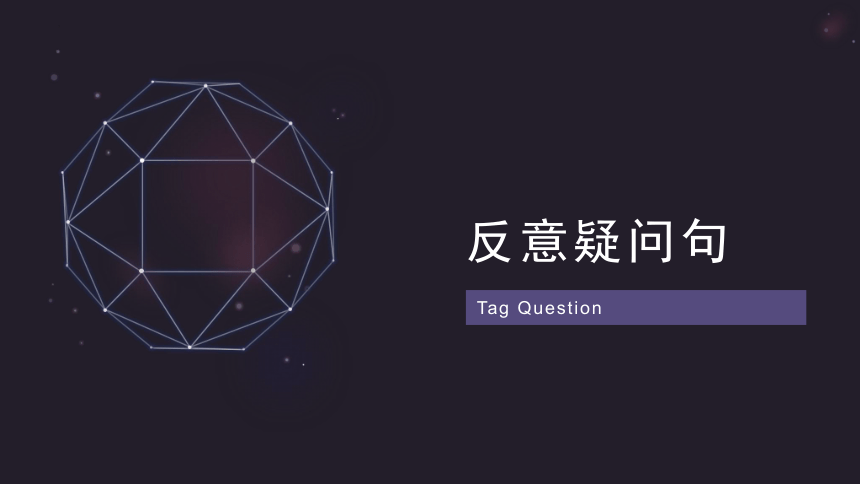 | |
| 格式 | pptx | ||
| 文件大小 | 1.2MB | ||
| 资源类型 | 教案 | ||
| 版本资源 | 人教版(2019) | ||
| 科目 | 英语 | ||
| 更新时间 | 2022-10-20 22:15:49 | ||
图片预览

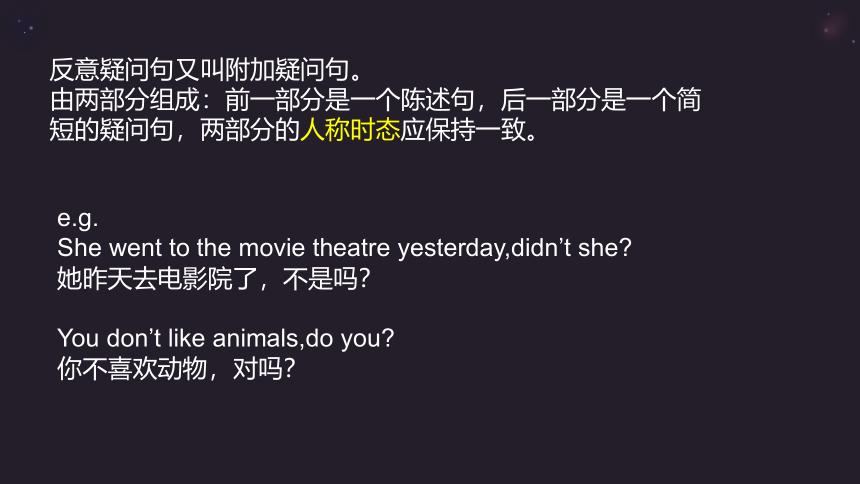
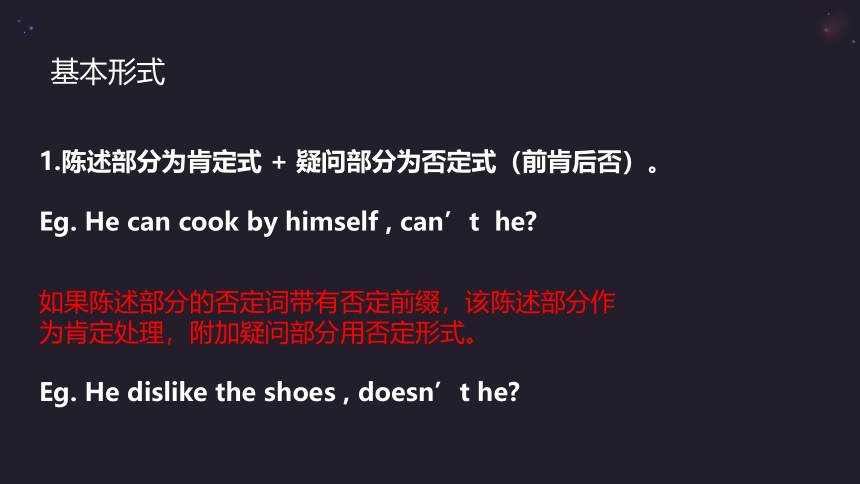
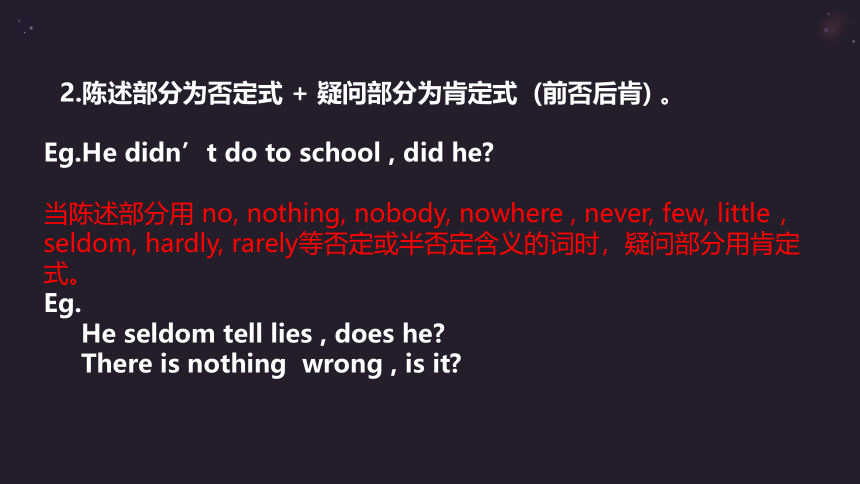
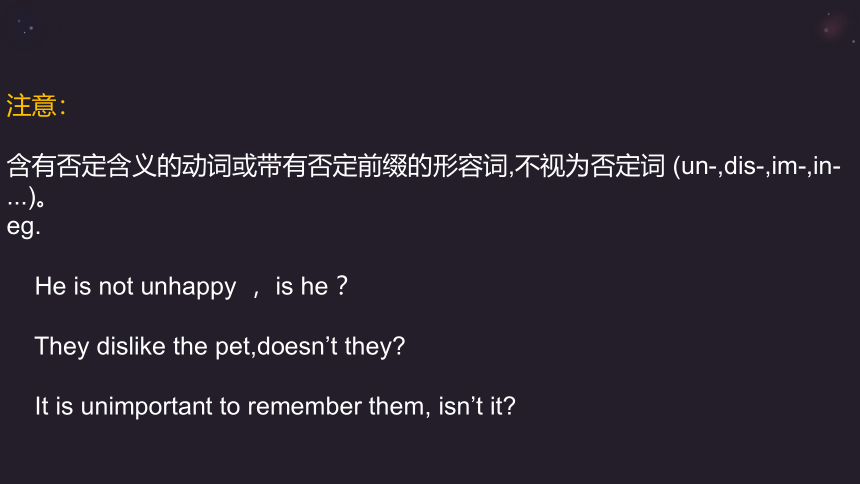
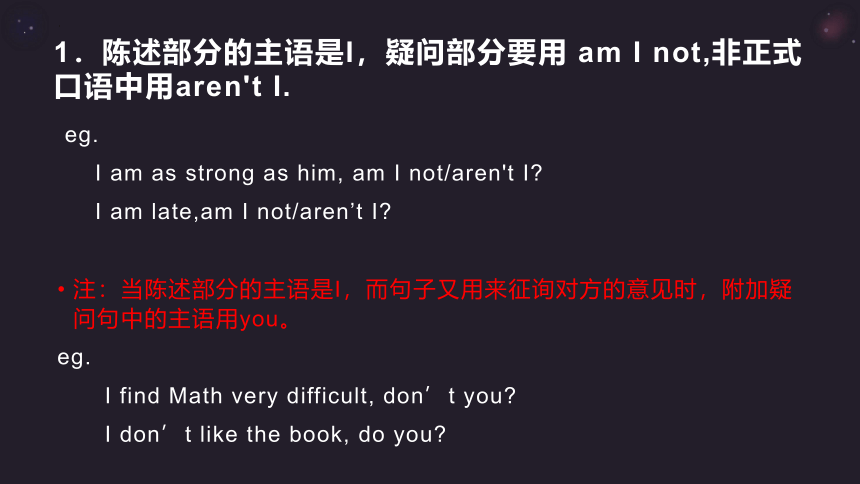
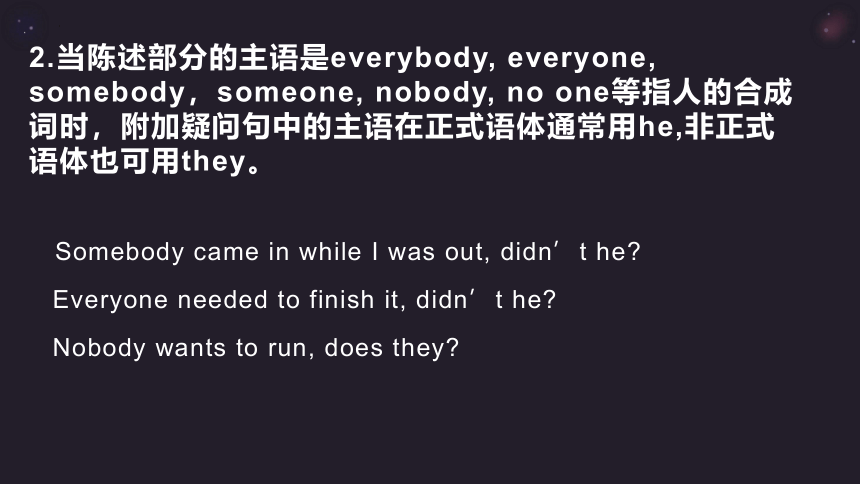
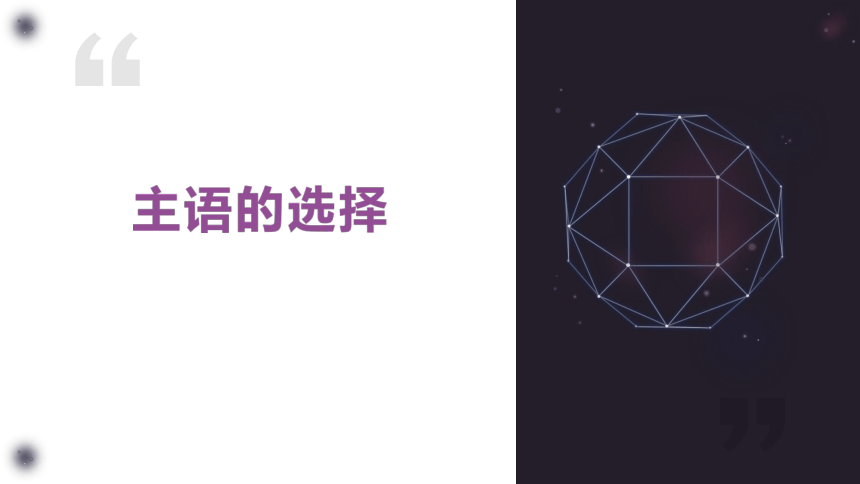
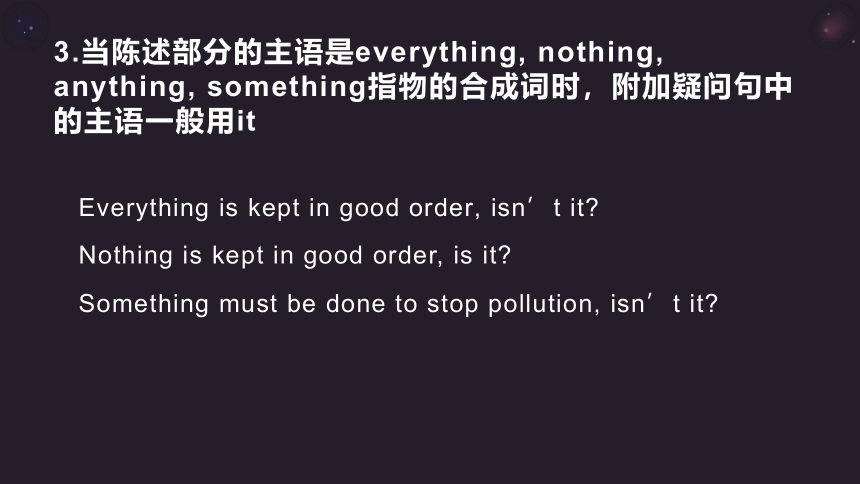
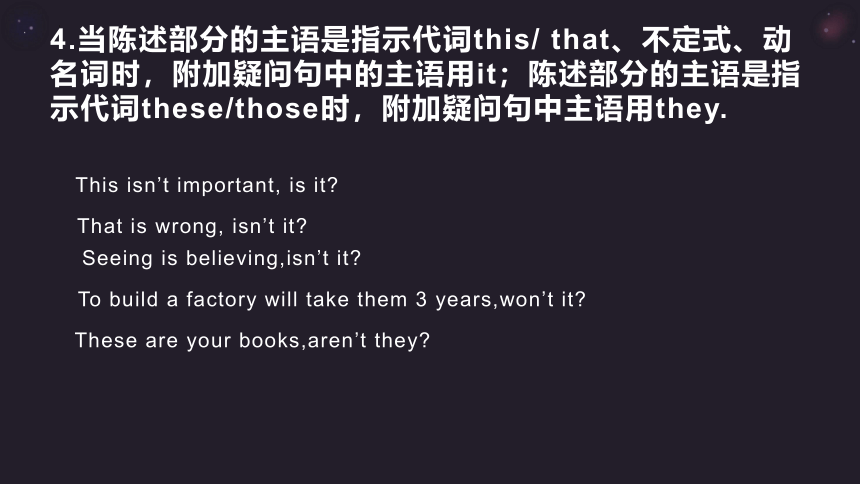
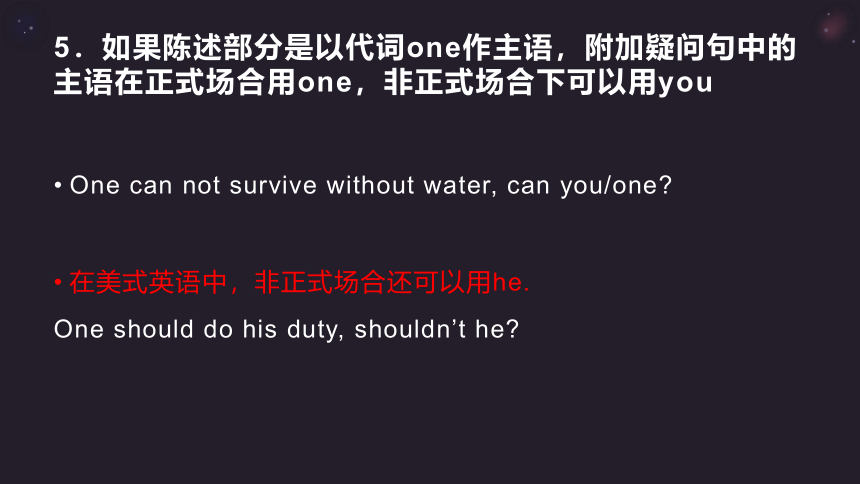
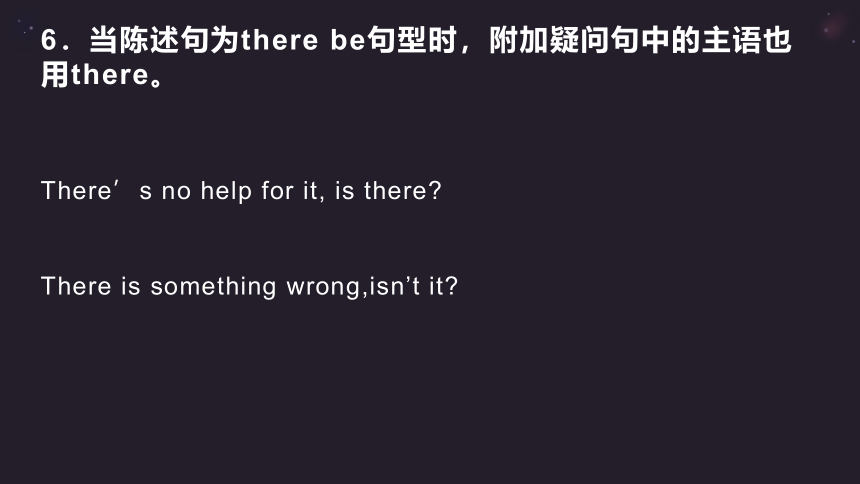
文档简介
(共34张PPT)
反意疑问句
Tag Question
反意疑问句又叫附加疑问句。
由两部分组成:前一部分是一个陈述句,后一部分是一个简短的疑问句,两部分的人称时态应保持一致。
e.g.
She went to the movie theatre yesterday,didn’t she
她昨天去电影院了,不是吗?
You don’t like animals,do you
你不喜欢动物,对吗?
1.陈述部分为肯定式 + 疑问部分为否定式(前肯后否)。
Eg. He can cook by himself , can’t he
如果陈述部分的否定词带有否定前缀,该陈述部分作为肯定处理,附加疑问部分用否定形式。
Eg. He dislike the shoes , doesn’t he
基本形式
2.陈述部分为否定式 + 疑问部分为肯定式 (前否后肯) 。
Eg.He didn’t do to school , did he
当陈述部分用 no, nothing, nobody, nowhere , never, few, little ,seldom, hardly, rarely等否定或半否定含义的词时,疑问部分用肯定式。
Eg.
He seldom tell lies , does he
There is nothing wrong , is it
注意:
含有否定含义的动词或带有否定前缀的形容词,不视为否定词 (un-,dis-,im-,in-...)。
eg.
He is not unhappy ,is he ?
They dislike the pet,doesn’t they
It is unimportant to remember them, isn’t it
1.陈述部分的主语是I,疑问部分要用 am I not,非正式口语中用aren't I.
eg.
I am as strong as him, am I not/aren't I
I am late,am I not/aren’t I
注:当陈述部分的主语是I,而句子又用来征询对方的意见时,附加疑问句中的主语用you。
eg.
I find Math very difficult, don’t you
I don’t like the book, do you
2.当陈述部分的主语是everybody, everyone, somebody,someone, nobody, no one等指人的合成词时,附加疑问句中的主语在正式语体通常用he,非正式语体也可用they。
Somebody came in while I was out, didn’t he
Everyone needed to finish it, didn’t he
Nobody wants to run, does they
主语的选择
3.当陈述部分的主语是everything, nothing, anything, something指物的合成词时,附加疑问句中的主语一般用it
Everything is kept in good order, isn’t it
Nothing is kept in good order, is it
Something must be done to stop pollution, isn’t it
4.当陈述部分的主语是指示代词this/ that、不定式、动名词时,附加疑问句中的主语用it;陈述部分的主语是指示代词these/those时,附加疑问句中主语用they.
This isn’t important, is it
That is wrong, isn’t it
Seeing is believing,isn’t it
To build a factory will take them 3 years,won’t it
These are your books,aren’t they
5.如果陈述部分是以代词one作主语,附加疑问句中的主语在正式场合用one,非正式场合下可以用you
One can not survive without water, can you/one
在美式英语中,非正式场合还可以用he.
One should do his duty, shouldn’t he
6.当陈述句为there be句型时,附加疑问句中的主语也用there。
There’s no help for it, is there
There is something wrong,isn’t it
7.当陈述部分为主从复合句时,附加疑问句部分的主语和谓语一般与主句中的主语和谓语动词保持一致 ;
If he had come yesterday,you might have seen him,mightn’t you
He said that he should come back next Monday,didn't he?
We told him we would go there next week ,didn't we ?
They don’t believe she is an engineer,do they
但当陈述部分的主句是 第一人称主语 + think,believe,suppose,
suspect,expect等结构时,附加疑问句部分与宾语从句中的主语和谓语保持一致。
I suppose that he’s serious isn’t he
I beieve she can do it,can she
注意否定的转移
I don’t think she cares, does she
I don’t think he will arrive in time ,will he
8.当陈述部分是并列句,附加疑问句则与就近的分句的主语和谓语一致。
Jack has been writing letters all afternoon but he should finish them now, shouldn’t he
She is a diligent student and she often helps others ,doesn’t she
9.由“祈使句+附加疑问”构成的附加疑问句中,附加疑问部分的主语一般用you。
肯定祈使句,疑问部分一般用 won’t you / will you / would you
否定祈使句,疑问部分一般用 will you
Sit down,won’t you (表示邀请) 请坐。
Be quiet,would you 安静,好吗?
Don’t open the door, will you 不要开门,好吗?
但以let’s开头的祈使句,附加疑问部分用shall we;以let us开头的祈使句,如果含义是allow us,不包括听话人在内,疑问部分用will you。
即 Let’s...,shall we
Let us...,will you
Let’s go shopping,shall we
Let us go now,will you
谓语动词的选择
1.当陈述部分带有情态动词must时
当must表示“必须”时,疑问部分用mustn’t;当must表示“有必要时,疑问部分也可以用needn’t。
You must work hard next term, mustn’t you
I must answer the letter, mustn’t I/needn’t I
如果陈述句部分mustn't表示禁止,疑问句部分要用must。
You mustn't laugh,must you?你不许笑,知道吗?
当must表推测这层含义时,不能用must,而要根据陈述部分的不定式结构(即must之后的动词)以及含义采用相应的动词形式。
eg.
You must know the answer to the question ,don't you ?
He must be in the library, isn’t he
当must have done表示对过去的情况进行推测(一般句中有明确的过去时间状语),问句要根据陈述部分谓语的情况用“didn't”或“wasn't/weren't”
She must have watched the movie last week, didn’t she
They must have seen Tom last week, didn’t they
如果强调动作的完成(一般没有明确的过去时间状语),问句要用“haven't/hasn't+主语”。
You must have made a mistake, haven’t you
You must have left your bag in the theatre,haven't you ?
2.当陈述部分含有used to时,疑问部分可用usedn’t或didn’t。
He used to smoke ,didn’t/usedn’t he
Tom used to live in the countryside, usedn’t /didn’t he
3.当陈述部分带有情态动词ought to时,疑问部分用oughtn’t或shouldn’t。
He ought to go there, oughtn’t/shouldn’t he
We ought to read this book, oughtn’t/ shouldn’t we
4.当陈述句部分含有dare或need时
当陈述部分含有情态动词dare或need时,疑问部分常用 need /dare +主语。
We need not do it again, need we
He dare not say so, dare he
但当dare, need 为实义动词时,疑问部分用助动词do 的形式+ 主语。
She doesn't dare to go home alone, does she
He need bring his book with him,needn’t him
5.当陈述部分含有had better时,疑问部分用hadn’t。
You’d better finish your homework now, hadn’t you
6.感叹句后的附加疑问句的谓语动词需用be的现在时,且常用否定形式。
What a clever boy, isn’t he
What a lovely day, isn’t it
7.陈述句中的谓语动词是wish,表示愿望时,附加疑问句用may,且用肯定形式。
I wish to shake hands with you,may I
I wish to have a chance to meet him,may I
8.当陈述部分带有表示“拥有”含义的动词have(has)时,疑问部分既可用have形式,也可用do形式。
You have a new bike, haven’t /don’t you
She has a sister,hasn’t/doesn’t she
She doesn’t have any money in her pocket, does she
9.陈述部分有have to +v. (had to + v.),疑问部分常用don't +主语(didn't +主语)。
We have to get there at eight tomorrow, don't we
He had to move to the downtown,didn’t he
10.陈述部分有would rather +v.,疑问部分多用 wouldn't +主语。
He would rather stay at home rather than go out, wouldn't he
11.陈述部分有You'd like to +v. 疑问部分用wouldn't +主语.
You'd like to go with me, wouldn't you
11.同向反意疑问句,为了加强语气,只是表示某种惊奇、怀疑、反感、讽刺等感情而并不是为了寻求回答,这时前后两部分的肯定、否定是一致的。 有时用oh和so加强语气。
Oh, he is an artist, is he
So, you will come with me,will you
You’ll no t go, won’t you
Oh,Jasime isn’t Janny ‘s mother,isn’t she
反意疑问句的回答
反意疑问句的回答
对反意疑问句的回答,无论问题的提法如何,如果事实是肯定的,就用yes,事实是否定的,就要用no。
—He likes singing, doesn’t he 他喜欢唱歌,是吗?
—Yes, he does. / No, he doesn’t. 是的,他喜欢。/ 不是,他不喜欢。
当陈述句部分是否定结构,附加疑问句部分用肯定式提问时,回答yes或no与汉语的意思正好相反。这种回答的yes要译成“不”,no要译成“是”。
—He didn’t go to school, did she 他没去上学,是吗?
—Yes, he did. / No, he didn’t. 不,他去了。/ 是的,他没去。
Thank You
反意疑问句
Tag Question
反意疑问句又叫附加疑问句。
由两部分组成:前一部分是一个陈述句,后一部分是一个简短的疑问句,两部分的人称时态应保持一致。
e.g.
She went to the movie theatre yesterday,didn’t she
她昨天去电影院了,不是吗?
You don’t like animals,do you
你不喜欢动物,对吗?
1.陈述部分为肯定式 + 疑问部分为否定式(前肯后否)。
Eg. He can cook by himself , can’t he
如果陈述部分的否定词带有否定前缀,该陈述部分作为肯定处理,附加疑问部分用否定形式。
Eg. He dislike the shoes , doesn’t he
基本形式
2.陈述部分为否定式 + 疑问部分为肯定式 (前否后肯) 。
Eg.He didn’t do to school , did he
当陈述部分用 no, nothing, nobody, nowhere , never, few, little ,seldom, hardly, rarely等否定或半否定含义的词时,疑问部分用肯定式。
Eg.
He seldom tell lies , does he
There is nothing wrong , is it
注意:
含有否定含义的动词或带有否定前缀的形容词,不视为否定词 (un-,dis-,im-,in-...)。
eg.
He is not unhappy ,is he ?
They dislike the pet,doesn’t they
It is unimportant to remember them, isn’t it
1.陈述部分的主语是I,疑问部分要用 am I not,非正式口语中用aren't I.
eg.
I am as strong as him, am I not/aren't I
I am late,am I not/aren’t I
注:当陈述部分的主语是I,而句子又用来征询对方的意见时,附加疑问句中的主语用you。
eg.
I find Math very difficult, don’t you
I don’t like the book, do you
2.当陈述部分的主语是everybody, everyone, somebody,someone, nobody, no one等指人的合成词时,附加疑问句中的主语在正式语体通常用he,非正式语体也可用they。
Somebody came in while I was out, didn’t he
Everyone needed to finish it, didn’t he
Nobody wants to run, does they
主语的选择
3.当陈述部分的主语是everything, nothing, anything, something指物的合成词时,附加疑问句中的主语一般用it
Everything is kept in good order, isn’t it
Nothing is kept in good order, is it
Something must be done to stop pollution, isn’t it
4.当陈述部分的主语是指示代词this/ that、不定式、动名词时,附加疑问句中的主语用it;陈述部分的主语是指示代词these/those时,附加疑问句中主语用they.
This isn’t important, is it
That is wrong, isn’t it
Seeing is believing,isn’t it
To build a factory will take them 3 years,won’t it
These are your books,aren’t they
5.如果陈述部分是以代词one作主语,附加疑问句中的主语在正式场合用one,非正式场合下可以用you
One can not survive without water, can you/one
在美式英语中,非正式场合还可以用he.
One should do his duty, shouldn’t he
6.当陈述句为there be句型时,附加疑问句中的主语也用there。
There’s no help for it, is there
There is something wrong,isn’t it
7.当陈述部分为主从复合句时,附加疑问句部分的主语和谓语一般与主句中的主语和谓语动词保持一致 ;
If he had come yesterday,you might have seen him,mightn’t you
He said that he should come back next Monday,didn't he?
We told him we would go there next week ,didn't we ?
They don’t believe she is an engineer,do they
但当陈述部分的主句是 第一人称主语 + think,believe,suppose,
suspect,expect等结构时,附加疑问句部分与宾语从句中的主语和谓语保持一致。
I suppose that he’s serious isn’t he
I beieve she can do it,can she
注意否定的转移
I don’t think she cares, does she
I don’t think he will arrive in time ,will he
8.当陈述部分是并列句,附加疑问句则与就近的分句的主语和谓语一致。
Jack has been writing letters all afternoon but he should finish them now, shouldn’t he
She is a diligent student and she often helps others ,doesn’t she
9.由“祈使句+附加疑问”构成的附加疑问句中,附加疑问部分的主语一般用you。
肯定祈使句,疑问部分一般用 won’t you / will you / would you
否定祈使句,疑问部分一般用 will you
Sit down,won’t you (表示邀请) 请坐。
Be quiet,would you 安静,好吗?
Don’t open the door, will you 不要开门,好吗?
但以let’s开头的祈使句,附加疑问部分用shall we;以let us开头的祈使句,如果含义是allow us,不包括听话人在内,疑问部分用will you。
即 Let’s...,shall we
Let us...,will you
Let’s go shopping,shall we
Let us go now,will you
谓语动词的选择
1.当陈述部分带有情态动词must时
当must表示“必须”时,疑问部分用mustn’t;当must表示“有必要时,疑问部分也可以用needn’t。
You must work hard next term, mustn’t you
I must answer the letter, mustn’t I/needn’t I
如果陈述句部分mustn't表示禁止,疑问句部分要用must。
You mustn't laugh,must you?你不许笑,知道吗?
当must表推测这层含义时,不能用must,而要根据陈述部分的不定式结构(即must之后的动词)以及含义采用相应的动词形式。
eg.
You must know the answer to the question ,don't you ?
He must be in the library, isn’t he
当must have done表示对过去的情况进行推测(一般句中有明确的过去时间状语),问句要根据陈述部分谓语的情况用“didn't”或“wasn't/weren't”
She must have watched the movie last week, didn’t she
They must have seen Tom last week, didn’t they
如果强调动作的完成(一般没有明确的过去时间状语),问句要用“haven't/hasn't+主语”。
You must have made a mistake, haven’t you
You must have left your bag in the theatre,haven't you ?
2.当陈述部分含有used to时,疑问部分可用usedn’t或didn’t。
He used to smoke ,didn’t/usedn’t he
Tom used to live in the countryside, usedn’t /didn’t he
3.当陈述部分带有情态动词ought to时,疑问部分用oughtn’t或shouldn’t。
He ought to go there, oughtn’t/shouldn’t he
We ought to read this book, oughtn’t/ shouldn’t we
4.当陈述句部分含有dare或need时
当陈述部分含有情态动词dare或need时,疑问部分常用 need /dare +主语。
We need not do it again, need we
He dare not say so, dare he
但当dare, need 为实义动词时,疑问部分用助动词do 的形式+ 主语。
She doesn't dare to go home alone, does she
He need bring his book with him,needn’t him
5.当陈述部分含有had better时,疑问部分用hadn’t。
You’d better finish your homework now, hadn’t you
6.感叹句后的附加疑问句的谓语动词需用be的现在时,且常用否定形式。
What a clever boy, isn’t he
What a lovely day, isn’t it
7.陈述句中的谓语动词是wish,表示愿望时,附加疑问句用may,且用肯定形式。
I wish to shake hands with you,may I
I wish to have a chance to meet him,may I
8.当陈述部分带有表示“拥有”含义的动词have(has)时,疑问部分既可用have形式,也可用do形式。
You have a new bike, haven’t /don’t you
She has a sister,hasn’t/doesn’t she
She doesn’t have any money in her pocket, does she
9.陈述部分有have to +v. (had to + v.),疑问部分常用don't +主语(didn't +主语)。
We have to get there at eight tomorrow, don't we
He had to move to the downtown,didn’t he
10.陈述部分有would rather +v.,疑问部分多用 wouldn't +主语。
He would rather stay at home rather than go out, wouldn't he
11.陈述部分有You'd like to +v. 疑问部分用wouldn't +主语.
You'd like to go with me, wouldn't you
11.同向反意疑问句,为了加强语气,只是表示某种惊奇、怀疑、反感、讽刺等感情而并不是为了寻求回答,这时前后两部分的肯定、否定是一致的。 有时用oh和so加强语气。
Oh, he is an artist, is he
So, you will come with me,will you
You’ll no t go, won’t you
Oh,Jasime isn’t Janny ‘s mother,isn’t she
反意疑问句的回答
反意疑问句的回答
对反意疑问句的回答,无论问题的提法如何,如果事实是肯定的,就用yes,事实是否定的,就要用no。
—He likes singing, doesn’t he 他喜欢唱歌,是吗?
—Yes, he does. / No, he doesn’t. 是的,他喜欢。/ 不是,他不喜欢。
当陈述句部分是否定结构,附加疑问句部分用肯定式提问时,回答yes或no与汉语的意思正好相反。这种回答的yes要译成“不”,no要译成“是”。
—He didn’t go to school, did she 他没去上学,是吗?
—Yes, he did. / No, he didn’t. 不,他去了。/ 是的,他没去。
Thank You
